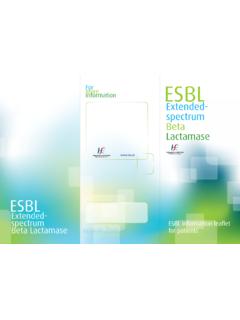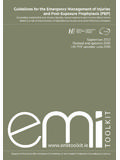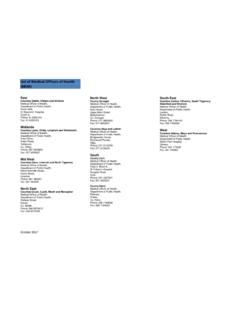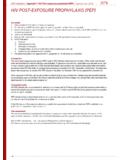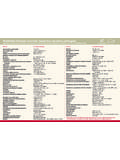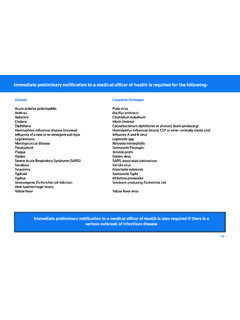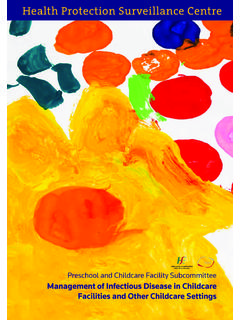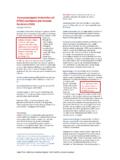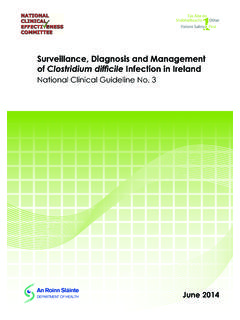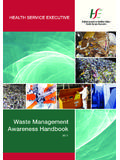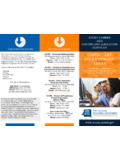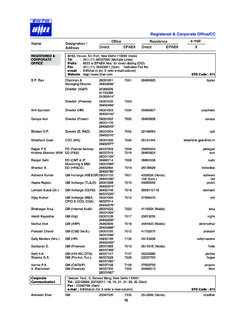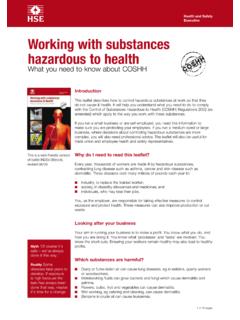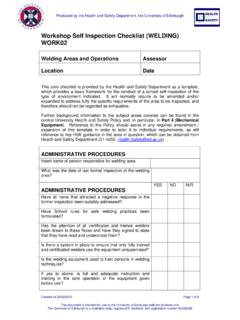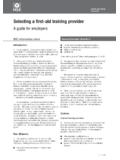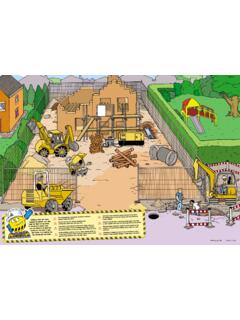Transcription of Standard Precautions - HPSC
1 Standard Precautions version 28th April 2009 1 Standard Precautions These guidelines must be implemented b y all healthcare workers Standard Precautions version 28th April 2009 2 Table of Contents Forward 3 Introduction 4 What is the rationale for Standard Pr e c a u t i o n s ? 4 How i nf ect i o n i s transmitted? 5 Chain of Infection 5 Standard Precautions 7 Transmission-Based Precautions 7 Responsibilities 8 Clinical Work Practices in Standard Precautions 9-18 References 19 Appendix A 20 Standard Precautions version 28th April 2009 3 Foreword This document is aimed at all healthcare workers delivering care to all patients in all settings This document is adapted from the Guideline for Isolation Precautions .
2 Preventing Transmission of Infectious Agents in Healthcare Settings, 2007 published by the Centre of Disease Control ( ) Each healthcare facility (including community care areas) must develop local guidelines on Standard Precautions , using if desired this document as a template Standard Precautions version 28th April 2009 4 1. Introduction What are Standard Precautions ? Standard Precautions are evidence based clinical work practices published by the Centre of Disease Control (CDC) in 1996 and updated in 2007 that prevent transmission of infectious agents in healthcare settings. (Siegal JD, Rhinehart E, Jackson M, Chiarello L, and the Healthcare Infection Control Practices Advisory Committee, Guideline for Isolation Precautions : Preventing Transmission of Infectious Agents in Healthcare Settings, 2007) Standard Precautions require all HCW s to: a.
3 Assume that every person is potentially infected or colonized with an organism that could be transmitted in the healthcare setting. b. apply a set of work practices to blood, all body fluids except sweat, mucous membranes and non intact skin including: hand hygiene use of personal protective equipment management of spillages of blood and body fluids appropriate patient placement management of sharps safe injection practices respiratory hygiene and cough etiquette management of needle stick injuries management of waste management of laundry decontamination of reusable medical equipment decontamination of the environment. What is the rationale for Standard Precautions ? Within a healthcare setting both patients and healthcare staff are at risk of acquiring at infection Risk to Patients It has been estimated that 1 in 10 patients acquire a healthcare associated infection (HCAI) (PHLS 1995) Risk to Healthcare staff Infection is an occupational risk for healthcare staff.
4 Exposure to blood and body fluids from infected patients poses a risk of infection with hepatitis B. C or HIV for healthcare staff (Cloeren, M 1998) Standard Precautions version 28th April 2009 5 How is infection transmitted? Transmission of infection occurs when the 6 elements of the Chain of Infection are present Chain of Infection (see figure 1) The chain of infection is a way of describing how disease is transmitted from one living thing to another 1. Infectious agent An infectious agent is an organism that causes disease: bacteria viruses fungi protozoa prions There are two sources of infection: A . endogenous or self infection occurs when organisms which are harmless in one site cause infection when transferred to another E coli.
5 B. exogenous or cross infection occurs when organisms are transferred from another source nurse, doctor, other patient, the environment. 2. Reservoirs A reservoir is a place where an infectious agent lives and grows ( large intestine, blood, mouth) 3. Portal of exit A portal of exit is any body opening that allows the infectious agent to leave ( mouth, nose, rectum, breaks in the skin,) 4. Means of transmission The means of transmission is how the infectious agent travels from the infected person to another person air, contact (indirect and direct) 5. Portal of entry The portal of entry is any body opening that allows the infectious agent to enter ( nose, mouth, eyes, mucous membranes, a break in the skin, a device inserted into the skin etc) 6. A susceptible host A susceptible host is a non infected person who could get infected Standard Precautions version 28th April 2009 6 Figure 1 Chain of Infection The purpose of Standard Precautions is to break the chain of infection focusing particularly but not exclusively on the mode of transmission, portal of entry and susceptible host sections of the chain.
6 Aseptic technique and antibiotic prophylaxis while not components of Standard Precautions are other key practices used to break the Chain of Infection at the infectious agent, reservoir and portal of exit sections of the chain Standard Precautions version 28th April 2009 7 Standard Precautions and the Chain of Infection Wh i l e the implementation of Standard Precautions breaks the chain of infection thus minimising transmission of infection within the Healthcare environment some highly transmissible infections required additional Precautions to Standard Precautions . These additional Precautions are Transmission-based Precautions . Transmission-Based Precautions Transmission-based Precautions are Contact, Airborne and Droplet Precautions Contact Precautions Contact Precautions should be applied in addition to Standard Precautions to prevent transmission of highly transmissible organisms that are transmitted from person to person via the contact route ( Meticillin resistant Staphylococcus aureus) Airborne Precautions Airborne Precautions should be applied, in addition to Standard Precautions , to prevent transmission of highly transmissible organisms that are transmitted via the air from one person to another ( Tuberculosis)
7 Droplet Precautions Droplet Precautions should be applied, in addition to Standard Precautions , to prevent transmission of highly transmissible organisms that are transmitted via respiratory secretions from one person to another ( Influenza) Standard Precautions version 28th April 2009 8 Responsibilities Healthcare workers All healthcare workers are responsible for: implementing Standard Precautions at all times attending induction and ongoing training on Standard Precautions reporting any deficits in knowledge or resources to line managers reporting any illness as a result of occupational exposure not attending for duty with known or suspected infection without first informing occupational Health department advising visitors of infection prevention and control requirements such as hand hygiene and cough etiquette Managers of Healthcare facilities Mangers of Healthcare facilities are responsible for ensuring that the resources necessary to implement Standard Precautions are provided including.
8 An infection prevention and control service an occupational health service an infection prevention and control induction programme for new staff an ongoing infection prevention and control education programme for staff equipment ( personal protective equipment, cleaning equipment) physical infrastructure (isolation rooms, hand wash sinks etc) development of an action plan to address any non compliance with Standard Precautions identified by regular audits (see ) Infection Prevention and Control staff Infection Prevention and Control staff are responsible for; providing education on Standard Precautions to all staff ensuring local guidelines and policies on Standard and Transmission- based Precautions are in place and regularly reviewed surveillance of epidemiology important organisms and notifable diseases providing ongoing advice to staff auditing implementation of Standard and Transmission-based Precautions in conjunction with relevant department/ward areas ( ward/hygiene managers) and feedback results to department/ward managers and healthcare managers (see ) Standard Precautions version 28th April 2009 9 Clinical work Practices in Standard Precautions The following pages (10-18) describe the Clinical Work Practices in Standard Precautions in detail.
9 A table with 4 columns has been used to present the information (see table 1). Column 1 The format number Column 2 The name of the clinical work practice Column 3 A description of the clinical work practice that applies in Standard Precautions . References to other Irish publications and web sites that are relevant are included. Column 4 A graphic description of where the clinical work practice breaks the chain of infection Table 1 1 2 3 4 Clinical Work Practice Standard Precautions Breaking the Chain of infection Standard Precautions version 28th April 2009 10 Clinical Work Practice S T A N D A R D Precautions Breaking the Chain of Infection Occupational Health Programme All HCW s should be assessed by an occupational heath team prior to commencing work.
10 This assessment should include: immunisations (Irish guidelines on immunisations required for HCW s are available at # ) screening HCW s who perform exposure prone procedures for blood borne viruses. DoHC guidelines available at PATIENT PLACEME N T HCW s should include the potential for transmission of infectious agents in patient placement decisions Where possible, place patients who contaminate the environment or cannot maintain appropriate hygiene in isolation ro om s with en suite toilet facilities and ante room HAND HYGIENE Hand hygiene is recommended; before and after each episode of patient contact between individual patient contacts after contact with blood, body fluids,, secretions or excretions, whether or not gloves are wo r n after handling soiled/contaminated equipment, materials or the environment immediately after removing gloves or other protective clothing (see ) Hands may be decontaminated using both plain soap and water or if hands are physically clean, an alcohol based hand rub/ g e l Patients should wash their hands after toileting and before meals.
